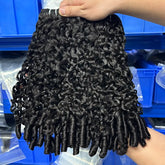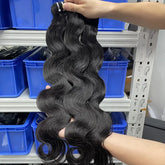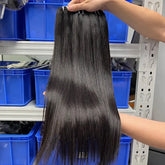“Raw Hair” Is Not Always Raw: 5 Hidden Tricks Vendors Use That Every Hair Reseller Should Know

Introduction
In today’s booming human hair market, the term “raw hair” is often used as a gold-standard promise — natural, unprocessed, and straight from the donor. But here’s the hard truth: not every bundle labeled raw is what it claims to be. For Black-owned salons, wig boutiques, and professional resellers, getting fooled can mean unhappy clients, refunds, and a damaged reputation. The good news? Once you know the tricks vendors use, you can spot them before they cost you money.
1. “Upgraded Remy” Sold as Raw Hair
What happens: Vendors take standard Remy hair (processed but cuticle-aligned), give it a light acid wash and reconditioning, then market it as raw.
Why they do it:
- Cheaper to source processed Remy than true raw.
- Finish looks “fresh” enough to fool first-time buyers.
How to detect it:
- Uniform color & overly smooth texture: raw hair usually shows slight shade variation and natural cuticle texture.
- Bleach test: processed Remy may lighten unevenly or show brassy tones fast.
- Expert tip: request unwashed samples — raw hair will feel slightly coarse before conditioning.
2. Old Hair Stock Sold as Fresh Raw Hair
What happens: Hair stored for months or years is reconditioned with oils or silicone sprays and sold as “fresh raw hair.”
Why it’s risky:
- Older hair can feel soft at first but becomes dry, brittle, and breaks after a few washes.
Spotting the trick:
- Strong artificial fragrance: used to mask musty storage smells.
- Split ends before washing: indicates age-related dryness.
- Expert tip: source from vendors who show real-time collection videos or prove recent batch sourcing.
3. The “Cuticle-Intact” Half-Truth
What happens: A vendor claims “cuticle intact” but some strands are reversed or partially removed.
Why they do it: Reversing/removing cuticles helps blend mixed batches and saves sorting time and cost.
Spotting the trick:
- Early shedding & tangling: misaligned cuticles create friction.
- Glossy, overly smooth feel: heavy silicone coatings mask missing cuticles.
- Expert tip: soak a small section in warm water and shampoo — if silky feel disappears, coating was hiding issues.
4. Mixing Remy and Non-Remy Hair
What happens: Bundles labeled raw remy actually contain a percentage of non-remy (cuticles facing different directions).
Why it’s risky: Non-remy tangles quickly once silicone washes off, causing complaints within weeks.
Prevention:
- Buy from suppliers who send batch photos or videos before shipment.
- Keep test bundles from each order to monitor longevity.
- Expert tip: if a “raw” price is very close to processed hair prices, that’s a red flag.
5. Color-Treated Hair Sold as “Natural Color”
What happens: Vendors dye hair to uniform dark brown or black to hide greys or blend donors, yet call it natural.
Why it’s a problem: Color-treated hair may resist bleaching, fade unevenly, or become brittle faster.
Testing method:
- Use a mild bleach patch test on a small section — true raw hair lifts gradually without strong chemical odors.
- Expert tip: natural raw hair from Vietnam/Cambodia often shows soft brown shades with slight variation; perfectly uniform color can signal dyeing.
Why This Matters for Black Hair Industry Professionals
For Black-owned salons, wig boutiques, and resellers serving textured-hair clients, quality is non-negotiable. A fake-raw bundle can:
- Damage trust with loyal customers
- Increase return rates and disputes
- Hurt your brand reputation in professional circles
Market context: reputable industry analyses show strong demand for premium natural hair; authenticity is a competitive advantage for businesses serving Black consumers.
Final Expert Checklist for Spotting True Raw Hair
- Source country & village of origin
- Proof of batch freshness
- Batch photos & videos (not stock images)
- Cuticle intact verification
- C hemical-free confirmation
Conclusion
Not every “raw hair” label tells the full story. By learning these five hidden vendor tricks, you’ll protect your business, your clients, and your reputation. If you’re serious about sourcing authentic raw hair from trusted origins like Burma, Cambodia, or Vietnam, start building direct supplier relationships today.
Looking for verified raw hair for your salon or store?
Explore Yara Hair’s Raw Hair Collection — sourced with transparency, tested for quality, and trusted by professionals worldwide.







